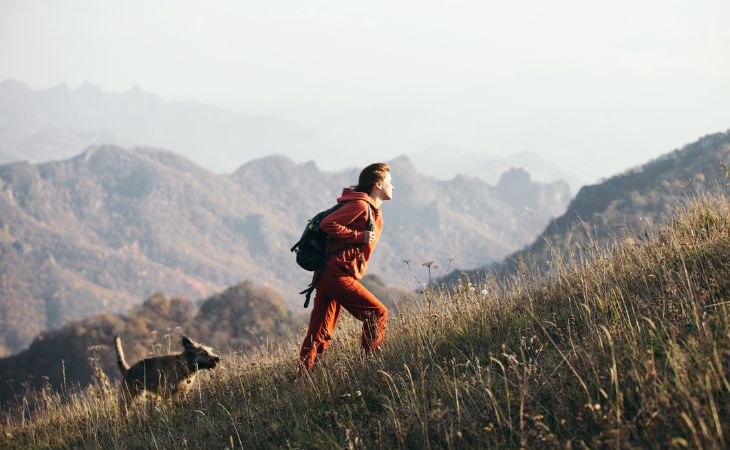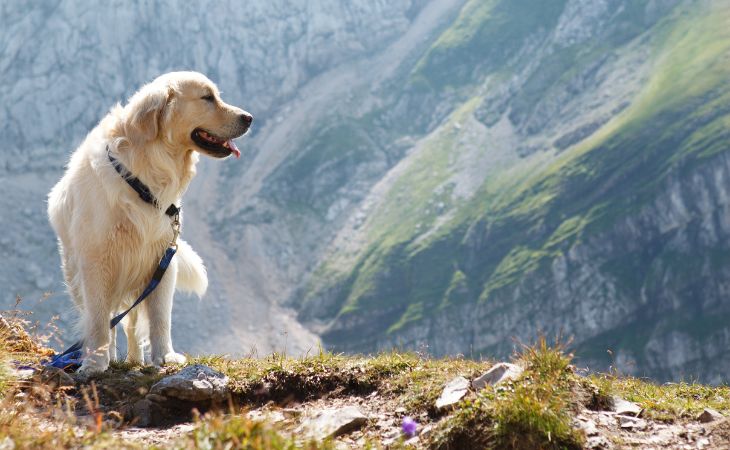If you decide to take your dog with you to the mountains, whether it be in the summer or in the winter, it’s important to keep in mind that it is not without dangers. But what are the risks? What precautions should be taken to keep your dog safe? In this article, we will give you some advice to help you keep your dog safe in the mountains.
Visiting the mountains in the winter
Spending time in the mountains with your dog allows you to bond and share great moments of happiness and freedom. However, depending on the season or the weather conditions, you’ll have to be vigilant to guarantee your dog’s safety.
Protect your dog from the cold
While dogs can handle the cold better than the heat, it’s still possible for dogs to get bronchitis or pneumonia. Their resistance to the cold has limits.
Not all dogs react in the same way when faced with the cold. It depends on their age, their size, their breed, and their health conditions. Short-haired dogs like Boxers, or dogs with undercoats like Poodles, will have a harder time handling the cold. On the other hand, dogs with medium-long to long hair like Golden Retrievers or with thick undercoats like Siberian Huskies will have much more resistance to the cold.
Small dogs such as the Yorkshire terrier do not handle the cold well. Therefore, it’s best to take a dog coat with you. For these types of breeds, wait until you return from the mountains before you groom them and cut their fur shorter.
A senior dog or a sick dog should be even more protected from the cold temperatures. This is because they have more difficulties generating body heat. In addition, puppies have less immune system defenses and are therefore more sensitive to the cold.
Lastly, an apartment dog will be less used to low temperatures than a dog who spends most of their time outside. If this is the case for your dog, make sure to protect them from the cold.
Be wary of the snow
It’s adorable to watch dogs play in the snow. They also absolutely love it. Unfortunately, they have a tendency to eat it to quench their thirst. If eaten in large quantities, it can give them diarrhea and make them vomit. Snow is not supposed to be swallowed. You should take a bowl and some water with you to give to your dog regularly.
Protect your dog’s paw pads from frostbite and cracks with little dog boots, shoes, or socks in neoprene. Without this protection, the snow can get in between their paw pads, creating little pieces of ice, sometimes abrasive, which can lead to lesions.
If their paw pads were damaged, there are balms that you can apply on their paw pads to repair them and prevent the condition from getting worse. You can also use a fortifying tanning spray to strengthen your dog’s paw pads. You have to apply this several weeks before you go to the mountains. It will make their paws pads impermeable and resistant.
Rolling in the snow is quite fun for dogs. However, when they do this, they are left with wet fur. You should not let your dog stay in the cold. Dry your dog as soon as possible with a microfiber towel.
Avoid road salt
Try to avoid having your dog walk on road salt. If it is unavoidable, rinse your dog’s paws with clear water as soon as you get back from the walk. This is to avoid skin burns, but also, to prevent them from licking it and ingesting the salt. This can intoxicate them.
Anti-freeze products used to prevent passerbys from slipping is also irritating for the paws like salt. You can buy sprays to rehydrate the paw pads and help the pounds heal.
Feed your dog more than usual
To help your dog fight against the low temperatures, dogs needs energy. Therefore, you need to give your dog more to eat, but only if you are taking your dog on long walks.
Avoid long walks
If it is really cold outside or if there is a lot of snow fall and wind, it is best to go on short walks. By doing this, you will prevent your dog from losing too much body heat.
The reflection of the sun on the snow
In the mountains, the reflection of the sun on the snow is very strong, which is just as bad for humans as it is for dogs and can lead to eye issues. Even if sunglasses for dogs exist, these are not always tolerated by animals. Avoid exposing your dog to the reflection of the sun by bringing them to the shade, by going outside in the early morning or during the evening when the sun is setting.

Visiting the mountains in the summer
Going for a walk in the mountains in the summer with your dog is less dangerous than in the winter. But you should still be wary, attentive and keep an eye on your dog.
Go for a hike
A dog in good health, that it is not young or too old, will be able to enjoy long walks in the mountains. A small dog will have a harder time following you on paths that are too rocky. For this reason, it is best to adapt your hike to your dog. Some dogs have more endurance and are more agile than others. If your dog has a lot of energy, do not lost sight of them. Similar to us, dogs get used to the altitude progressively. They will need some time to adapt to the altitude.
In case of long and tiring walks, you can give some treats while on the hike. During the evening, after you get back home, you can give your dog a ration of food that is 20% more than their usual ration.
Sunburn
As strange as it sounds, dogs can get sunburned. It’s important to protect their muzzle, their ears, and all of the areas without hair with a sunscreen that is designed for dogs.
Staying hydrated
It is best to go on walks early in the morning or take breaks in the shade regularly. Even if they do not ask to drink, you need to give your dog water regularly. Prepare a bottle specifically for them, kept cold in a cooler or in an isolated pouch. Take advantage of the little rivers or lakes in the mountains to let your dog dip themselves in, as long as the water is not too cold. Dry them if necessary as soon as possible after the swim.
Prevent injuries
Like everywhere else, a dog can get injured. Do not leave for the mountains without bringing at the very least disinfectant products and strike compresses.
Keep an eye on your dog’s skin regularly to see if you spot presence of ticks that are often found in tall grass. Having a tick removing tool at hand is necessary.
If you see any foxtails in the mountains, these foxtails need to be taken off. They are very dangerous if inside the skin and even in the nose. After they are exposed to foxtails, look carefully at their paws and brush their fur to avoid having the foxtails cause any lesions.
Altitude
We know the effects that high altitudes can have on our bodies. For dogs, it’s a bit the same. If they are older, if they suffer from heart issues, or if they belong to one of the breeds that have a flat muzzle like Bulldogs, they will have a difficult time breathing. If this is the case, it is best to visit the mountains that are not too high up.
Living in the mountains: which breed is best for me?
If you live in the mountains yearlong or during just a part of the year, it is best to choose a dog that are suitable for this type of environment. Some breeds are better at handling the cold and the altitude and you will have no problems living in the mountains with these types of dogs. Huskies, Malamutes, Saint Bernards, and Newfoundland dogs are some dog breeds that can live happily in this area. However, Basset Hounds and Dachshunds, are not made for this type of weather. Their long body and short paws prevent them from walking correctly in the snow and can give them back pain.

